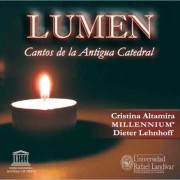Christmas Music from Renaissance Antigua
Written by Dieter Lehnhoff, Ph.D.
From the Renaissance to the late Baroque era (1534-1773) Santiago de Guatemala—present-day La Antigua Guatemala—was proud of its intense music life, rivaled only by Lima, Mexico City, and probably Bogotá. Beginning in 1524, early clergy had introduced Gregorian chant and choral polyphony for the different liturgical celebrations of the year, held in the first parish church built at Almolonga. From 1534 on, Bishop Francisco Marroquín established musical practice according to cathedral standards, with a fine polyphonic chorus, often supported by the pipe organs, which he had the organ builders construct for the cathedral. This choir sang in alternation with the Gregorian chant of the clergy during the numerous liturgies held in the cathedral and the churches of the beautiful city.
By 1570, the chapel master was Hernando Franco (1532-85), a Spanish musician trained at Salamanca. His duties were to conduct the choir at daily practices and liturgies, to teach the choirboys and to provide church music whenever it was needed. By 1574 Franco left for New Spain, where he was appointed chapel master of the Mexico City Cathedral. Music in Guatemala was then put in charge of Juan de Gamboa, a singer with a fine bass voice.
The last years of the century brought renewed brilliance, when composer Pedro Bermúdez (1558-1605) arrived to work at the Guatemala Cathedral. Bermúdez was one of the most prolific composers of Spanish America: he composed a collection of Vesper hymns for the entire year, plus two Masses, passion music, a series of invitatories for Christmas Matins services and numerous motets. By 1598 he was joined by Gaspar Fernández (1566-1629), an organist and composer who also compiled a collection of manuscript choir books. When Bermúdez left for Puebla de los Ángeles in New Spain in 1604, lured by a doubled salary, Fernández stayed in charge of music at the Guatemala Cathedral.
However, the elder musician died soon after arriving in Puebla, and Fernández as the most capable master in the area was invited to succeed him. He accepted, holding the position of chapel master in Puebla for the remaining 24 years of his life.
In Guatemala, the music contained in the choir books assembled by Fernández was sung year-round until the high Baroque, when other great composers such as Manuel de Quiroz and Rafael Antonio Castellanos were chapel masters. The music provided by the Renaissance masters, Franco, Bermúdez and Fernández, never lost its appeal and only had to be shelved when the great earthquake of 1773 brought enormous changes to the people of Santiago. When the capital was moved to its present day location by King Charles III’s orders, new churches were built. The ancient heavy choirbooks were repaired and recopied, being used only for services of great solemnity. They were shelved again during the 19th century, waiting to be rescued by scholars only in the latter part of the 20th century.
When I first viewed the ancient manuscripts in the early 1980s, I was surprised at the beauty of the music and decided to devote efforts to its revival. Thus, many long-forgotten works could come to life again, enchanting present-day audiences with their serene beauty as they did the dwellers of the City four centuries ago.
 A new recording of music for Advent and Christmas from Renaissance Antigua is being released by singer Cristina Altamira and conductor Dieter Lehnhoff with their Millennium Ensemble. The collection of Christmastide music by Hernando Franco, Pedro Bermúdez and Gaspar Fernández is titled Lumen (Light) and will bring the listener the serene joy of the season. Available in stores now.
A new recording of music for Advent and Christmas from Renaissance Antigua is being released by singer Cristina Altamira and conductor Dieter Lehnhoff with their Millennium Ensemble. The collection of Christmastide music by Hernando Franco, Pedro Bermúdez and Gaspar Fernández is titled Lumen (Light) and will bring the listener the serene joy of the season. Available in stores now.